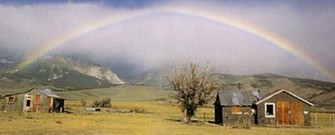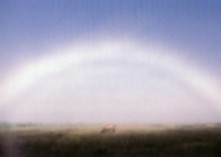
THE AIRLINE PILOTS FORUM & RESOURCE
Rainbow |
| Source: Excerpt from The Book " Weather " |
 |

Both dazzling and ephemeral, the rainbow has fired imaginations throughout time, often assuming great religious significance. However, it was not until the late 1660s that a scientific explanation for this phenomenon was provided. In a classic experiment, Isaac Newton showed that when a beam of light passed through a glass prism it was refracted, breaking down into a spectrum of colors. From this, he inferred that white light was in fact a combination of all the colors of the visible spectrum. This experiment suggested an explanation for the rainbow: raindrops act as millions of tiny prisms, breaking up sunlight into its component colors. When light hits a raindrop, most of it passes straight through, but light at the edges of the raindrop is refracted into the colors of the spectrum and then reflected off the back of the raindrop. It is then refracted again as it leaves. This refracted light leaves the raindrop at an angle of about 42 degrees from the incoming rays. Each color emerges at a slightly different angle, depending on its wavelength. Only one color will be visible from any one raindrop at a time, depending on the angle from which it is observed. The observer on the ground sees the combined refraction and reflection of light from millions of drops forming distinct bands of color: red, with the longest wavelength, is on the outside, ranging to violet on the inside.
A rainbow depends on the movement of the
raindrops, and the position of the Sun and the
observer. Because of these variables, no two
people will ever see precisely the same rainbow.
A secondary rainbow (right picture) sometimes appears above the primary bow when light is reflected twice off the back of the raindrops. WATCHING RAINBOWS Since rainbows are formed by the interaction of sunlight and rain, they normally occur during showery weather. To see the rainbow, the observer must be between the Sun and the shower. The brightest rainbows occur when the raindrops are large, because these disperse light better. A rainbow forms its greatest arc when the Sun is close to the horizon. The higher the Sun, the flatter the rainbow will be, until the Sun rises higher than 42 degrees above the horizon, when the rainbow will disappear altogether. If there were no horizon, the rainbow would appear as a full circle, as is sometimes observed from airplanes.
As rainbows depend on the Sun being close to the horizon, they are more common in the mornings and afternoons than in the middle of the day. This also means that they are more common in winter than in summer, and in middle and high latitudes than in the tropics.
In addition to rainbows, there are also moonbows and fogbows (right picture). A moonbow occurs when light reflected by the Moon refracts into visible colors on contact with rain. The resulting colors tend to be faint at best. Fogbows occur when sunlight strikes the water droplets in a fog. These bows are generally colorless, or almost colorless, because the tiny water droplets in fog don't disperse light well. |
Acknowledgement: John W. Zillman, William J. Burroughs,
Bob Crowder, Ted Robertson, Eleanor Vallier-Talbot and Richard Whitaker.


